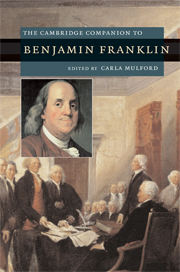Book contents
- Frontmatter
- Introduction
- 1 Benjamin Franklin’s library
- 2 The Art of Virtue
- 3 Franklin’s satiric vein
- 4 Franklin in the republic of letters
- 5 Benjamin Franklin’s natural philosophy
- 6 Franklin and the Enlightenment
- 7 Franklin and the question of religion
- 8 The pragmatist in Franklin
- 9 Franklin on national character and the Great Seal of the United States
- 10 Protestant ethic or conspicuous consumption? Benjamin Franklin and the Gilded Age
- 11 Benjamin Franklin and the American Dream
- 12 Benjamin Franklin’s Autobiography, then and now
- Further reading
- Index
6 - Franklin and the Enlightenment
Published online by Cambridge University Press: 28 January 2009
- Frontmatter
- Introduction
- 1 Benjamin Franklin’s library
- 2 The Art of Virtue
- 3 Franklin’s satiric vein
- 4 Franklin in the republic of letters
- 5 Benjamin Franklin’s natural philosophy
- 6 Franklin and the Enlightenment
- 7 Franklin and the question of religion
- 8 The pragmatist in Franklin
- 9 Franklin on national character and the Great Seal of the United States
- 10 Protestant ethic or conspicuous consumption? Benjamin Franklin and the Gilded Age
- 11 Benjamin Franklin and the American Dream
- 12 Benjamin Franklin’s Autobiography, then and now
- Further reading
- Index
Summary
Franklin and his contemporaries may never have seen themselves as members of a unified intellectual movement, but they did believe that their world was historically distinct in a number of ways. The term reason, contested as it was in the eighteenth century, widely served to signify this sense of distance from earlier periods. The same is true for the name, Benjamin Franklin, which came to stand for all sorts of things but almost always symbolized the promise or threat of a new age of human autonomy. “Had Franklin drawn lightning from the clouds [three hundred years ago],” Thomas Paine noted in The Age of Reason (1794), “it would have been at the hazard of expiring for it in the flames.” Paine implied that in the Middle Ages, Franklin's scientific discoveries - his disenchantment of nature - would have challenged the authority of the Catholic church, and he might have been burned at the stake. Yet in his own enlightened times, Franklin was seen as a representative man of his age, and his discoveries and inventions symbolized social and political revolutions of the highest magnitude, as in Turgot's popular witticism, “[Franklin] seized the lightning from the sky, and the sceptre from tyrants.”
Modern readers are duly suspicious of such utopian pronouncements. In hindsight, they recognize that the Enlightenment never existed as a homogenous set of ideas or as a coherent ideological program. Instead, opposing understandings of enlightened thought and action coexisted, not always peacefully. Different schools and creeds formed rigid antagonisms, surprising coalitions, new mixtures.
- Type
- Chapter
- Information
- The Cambridge Companion to Benjamin Franklin , pp. 77 - 90Publisher: Cambridge University PressPrint publication year: 2009
- 2
- Cited by

